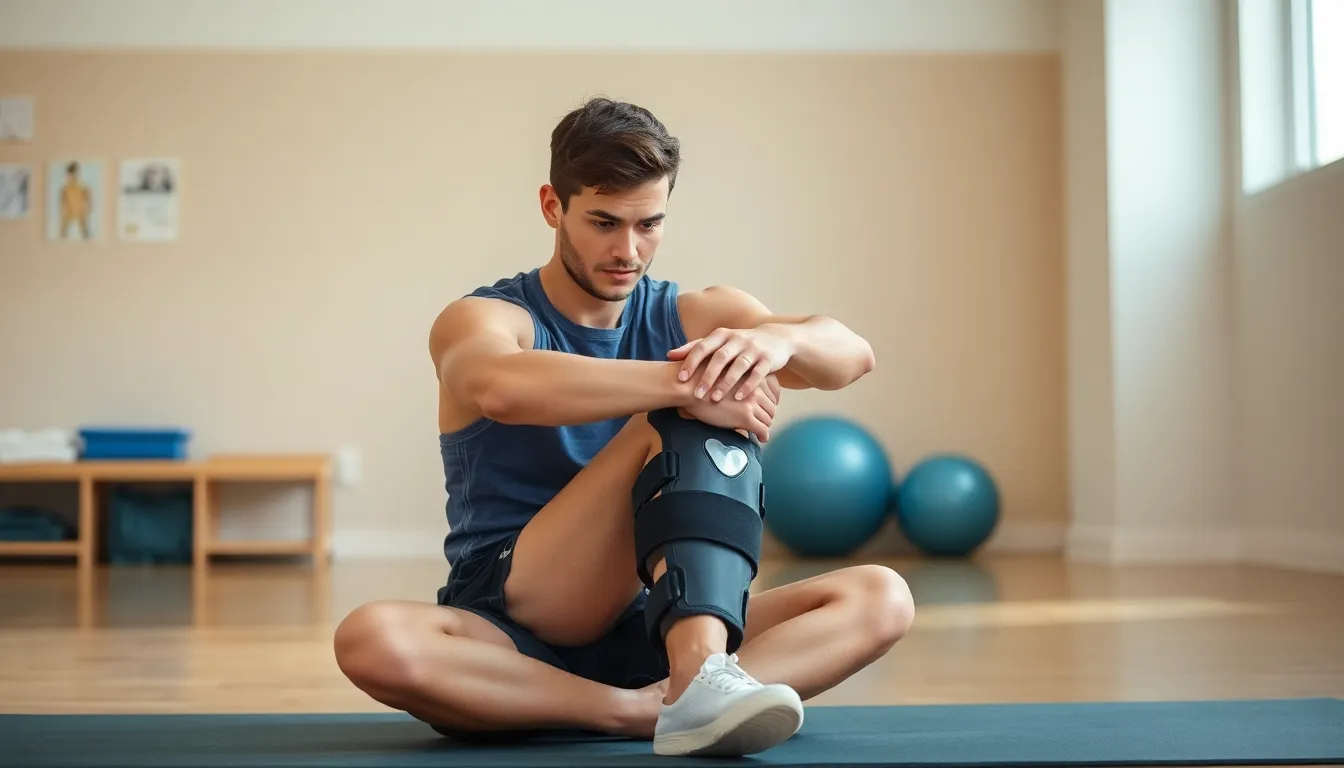When life throws a curveball and your MCL decides to take an unexpected vacation, it’s time to take action. Whether it’s from a sports mishap or just a clumsy moment, a sprained MCL can feel like a villain in your superhero story. But fear not! With the right strategies, he can turn that injury into a mere footnote in his epic saga.
Table of Contents
ToggleUnderstanding MCL Injuries
MCL injuries are common in athletes and active individuals. They typically result from stress or trauma to the knee.
Types of MCL Injuries
MCL injuries can be classified into three grades based on severity. Grade I involves mild stretching of the ligament, causing minimal pain and instability. Grade II signifies a partial tear, which results in moderate pain and some instability during movement. Grade III is a complete tear of the ligament, leading to significant pain, swelling, and joint instability. Understanding the type of injury aids in selecting appropriate treatment options.
Symptoms of MCL Injuries
Symptoms of MCL injuries vary depending on severity. Pain on the inner side of the knee often occurs. Swelling may develop around the joint within hours of the injury. Stiffness can limit movement and lead to difficulty in bending or straightening the knee. One might also notice instability or a feeling of looseness in the knee during activities. Recognizing these symptoms early enhances recovery chances.
Best Practices for MCL Healing

Effective healing of the MCL hinges on specific best practices. Following structured methods speeds up recovery and improves outcomes.
Rest and Recovery
Adequate rest remains crucial for MCL healing. Reducing activity after an injury prevents further damage and allows tissues to repair. Gradually introducing movement can help restore strength and flexibility. Physical therapy often plays a vital role, providing guided exercises to enhance recovery. Paying attention to body signals promotes a safer rehabilitation process. Supportive devices like braces may offer additional stability during recovery phases. Regular check-ins with a healthcare provider ensure that progress remains on track.
Ice and Compression
Applying ice can significantly reduce swelling and pain after an MCL injury. Using ice packs for 15-20 minutes every few hours helps manage inflammation effectively. Compression through elastic bandages stabilizes the knee and aids in swelling control. Tight but comfortable compression enhances support without restricting circulation. Alternating ice and compression techniques may yield better recovery results. Practicing this method consistently often leads to improved symptoms over time. Always monitor the application duration to avoid skin irritation.
Rehabilitation Techniques
Rehabilitation techniques play a crucial role in healing an MCL injury. Effective recovery relies on targeted approaches like physical therapy and specific exercises.
Physical Therapy Exercises
Physical therapy exercises promote healing through guided movement. Therapists assess individual needs to create customized programs, focusing on restoring range of motion and strength. Initial sessions typically include gentle movements to reduce stiffness, while progressive exercises address stability and support. Incorporating activities that replicate daily movements assists in regaining function. Adhering to a structured routine enhances recovery speed and outcomes.
Stretching and Strengthening
Stretching and strengthening maneuvers are essential for MCL rehabilitation. Flexibility exercises prevent stiffness, allowing the knee to recover properly. Specific stretches, such as quadriceps and hamstring stretches, enhance mobility and circulation. Strengthening exercises focus on quadriceps, hamstrings, and calves, providing the necessary support for the knee joint. Gradually increasing the intensity of these exercises optimizes strength and facilitates a faster return to activity. Prioritizing these practices ensures long-term stability and reduces the risk of reinjury.
Dietary Considerations
Diet plays a critical role in healing an MCL injury. Certain foods and nutrients can promote recovery and strengthen the knee.
Nutrition for Healing
A diet rich in protein aids tissue repair. Lean meats, fish, eggs, and legumes supply essential amino acids needed for recovery. Omega-3 fatty acids found in fatty fish, chia seeds, and walnuts help reduce inflammation. Incorporating plenty of fruits and vegetables provides antioxidants, supporting overall health and healing. Leafy greens like spinach and kale contain vitamin K, which is vital for joint health. Whole grains, such as quinoa and brown rice, offer sustained energy and help maintain weight during recovery.
Supplements to Consider
Certain supplements can support the healing process. Glucosamine is popular for joint health and may enhance cartilage repair. Omega-3 fish oil supplements can further reduce inflammation and promote recovery. Vitamin D supports bone healing and immune function, making it beneficial during rehabilitation. Calcium strengthens bones, while vitamin C aids collagen formation, essential for ligament repair. Before starting any supplements, a healthcare provider’s advice is crucial to ensure safety and effectiveness.
Alternative Remedies
Alternative remedies can complement traditional approaches to MCL healing. Exploring these options may enhance recovery.
Herbal Treatments
Herbal treatments offer potential benefits for MCL injuries. Turmeric contains curcumin, known for its anti-inflammatory properties, helping reduce swelling. Ginger also acts as a natural pain reliever, aiding in discomfort management. Additionally, arnica is often used topically to alleviate bruising and pain. Each of these herbs could provide supportive benefits during the healing process. Incorporating herbal supplements may enhance overall health, making it easier to engage in the rehabilitation process. Consulting with a healthcare provider ensures safe use and appropriate dosages.
Acupuncture and Other Therapies
Acupuncture serves as an alternative therapy for MCL injuries. This technique involves inserting thin needles into specific points on the body, promoting circulation and enhancing healing. Patients often report pain relief and reduced inflammation following sessions. Massage therapy provides additional support by relaxing tight muscles around the knee, improving mobility. Additionally, chiropractic adjustments can align the body to facilitate better healing. Each of these modalities, when included in a recovery plan, may contribute to a more comprehensive approach to rehabilitation. Seeking professional guidance ensures the most effective and safe treatment options.
Healing a sprained MCL requires a comprehensive approach that combines rest, rehabilitation, and nutrition. By prioritizing recovery techniques such as physical therapy and tailored exercises, individuals can significantly enhance their healing process. Incorporating a balanced diet rich in essential nutrients further supports tissue repair and overall joint health.
Exploring alternative remedies may also provide additional relief and promote healing. Staying in close communication with healthcare providers ensures that recovery remains on track and adjustments can be made as needed. With dedication and the right strategies, individuals can recover effectively and return to their active lifestyles stronger than before.

